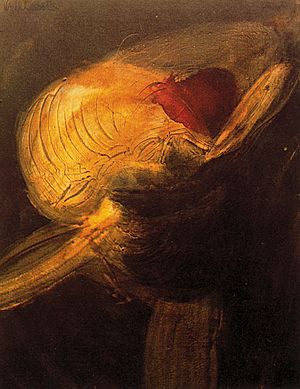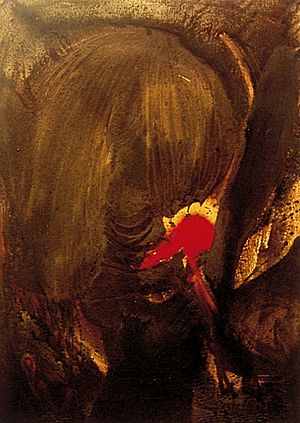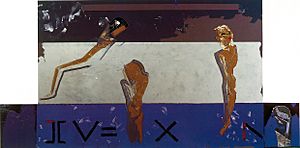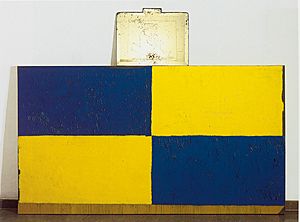Gaston Orellana facts for kids
Quick facts for kids
Gaston Orellana
|
|
|---|---|
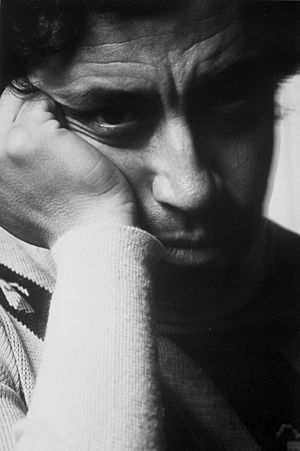
Gaston Orellana, photograph by Mimmo da Brescia, courtesy of Edizioni d'Arte Severgnini
|
|
| Born | 18 July 1933 |
| Education | Escuela de Bellas Artes de Viña del Mar, Chile; Universidad de Chile, Santiago; Royal Academy, London |
| Known for | painting |
|
Notable work
|
The Train in Flames, Crucifixion no 1, Triptico en forma de T Invertida |
| Movement | Neo-figurative, Post-conceptualism |
Gaston Orellana, born on July 18, 1933, is a famous painter with Spanish and Chilean roots. He was born in Valparaiso, Chile, but his parents were from Spain. His father, Armando de Orellana, was an engineer and a Spanish diplomat. His mother was Ernestina del Transito Morgadon.
Even though he was born in Chile, Gaston Orellana comes from a very old noble family in Spain. He has lived in many different countries, including Spain, Italy, the United States, the UK, and France.
Early Life and Art Beginnings
Gaston Orellana was born in Valparaiso because his father was working there as a Spanish diplomat. His brothers and sisters were also born in other countries where his father worked, like Brazil and Argentina.
Gaston first started studying art at a special school in Santiago, Chile. He then continued his art studies at the Escuela de Bellas Artes in Viña del Mar. He also became very good at playing the violin at the music school there.
In 1954, Orellana met the famous poet Pablo Neruda. They became very close friends, and their friendship lasted until the poet passed away. Neruda even wrote a poem for Orellana in 1966, praising his artwork.
Orellana also briefly studied archaeology and anthropology at the Universidad de Chile. After that, he went on an archaeological trip through Chile, Peru, Bolivia, and Argentina. This trip was led by Father Le Perc and the well-known archaeologist Antonio Diez de Medina. These studies greatly influenced his art later on.
After this time of intense learning, Orellana moved to Spain. He first stayed in Majorca and then settled in Madrid. There, in 1959, he helped start an art group called Grupo Hondo.
Developing His Style
In his first artworks, Orellana showed hints of a style that would later be called Neo-figuration. His figures were expressive but not always clearly defined. Many of his paintings from this time used mostly black and gray colors. Even though he used materials like oxides and sand, his paintings sometimes looked like watercolors.
On December 8, 1959, the Grupo Hondo group announced their ideas about Neo-figurative art in a special statement. Orellana was a key member of this group. During this period, Orellana became a mature artist. His paintings blended abstract art with a style that showed human figures in a deep, almost spiritual way. His art became richer in color and texture, showing his unique artistic expression.
Years in New York
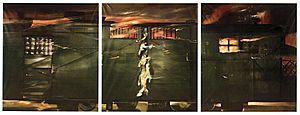
In 1964, Orellana took part in the first exhibition at the Juana Mordó Gallery in Madrid, Spain. He worked with this gallery for many years. The next year, he moved to New York City. Even though he lived in New York, he still traveled a lot to Spain, Italy, Switzerland, and the UK.
New York was a very exciting place for artists, and its lively art scene encouraged Orellana. He made friends with many important people, including James Johnson Sweeney, Bob Dylan, and Arthur Miller. He also met art dealers like Martha Jackson and poets like Allen Ginsberg.
In 1966, he started working closely with Martha Jackson, a New York art dealer. She introduced him to the art movement that led to a famous exhibition at the MOMA museum called "The New Image of Man." In 1969, Orellana joined Allen Ginsberg and other artists in protests against the Vietnam War.
During this time, Orellana also taught at The State University of New Jersey. He was part of the Art Coalition and wrote articles for New York magazines like Village Voice and Ramparts.
In 1970, Orellana represented Spain at the XXV Venice Biennale, a very important art exhibition. One of his most famous works shown there was Train in Flames. This huge painting was talked about a lot by art critics. A famous art collector named Joseph Hirshhorn bought this painting and other works from the exhibition. Train in Flames became a permanent part of the Hirshhorn Museum and Sculpture Garden when it opened in 1974.
In 1972, Orellana had his first exhibition with Christian Stein, an art dealer from Turin, Italy. They worked together for a long time. On August 3, 1974, he married Isabel Calles, and they had two children. In 1975, a book about Orellana's art from 1945 to 1975 was published in Madrid.
The paintings from his New York period often showed strong emotions and sometimes violence. However, they also had a beautiful, poetic quality that became a key part of his art. His art during this time combined his Spanish background, the influence of American art, his knowledge of ancient cultures, and new Italian art styles like Conceptualism and Arte Povera. All these influences came together to create new directions in Orellana's work.
Recent Years
In 1984, Orellana moved back to Europe. He lived and worked between his studios in Madrid, Spain, and Albisola, Italy. In 1985, he moved to Riva del Garda, Italy. This was a very productive time for him, and many art critics, dealers, and important politicians visited him there.
Orellana and his family moved back to Spain in 1993, settling in Trujillo, Extremadura. Finally, in 2000, they moved to France, where he still lives and creates art today.
In 1986, the Museo Español de Arte Contemporaneo held an exhibition of his works from 1970 to 1986. In 1991, he had an exhibition in Milan, Italy, in a space designed by the famous architect Renzo Piano. A very impressive exhibition also took place at the Taipei Fine Arts Museum in Taiwan, which received much praise from critics.
In 1995, a significant exhibition was held at the Casa Das Artes in Vigo, Spain. Critics said this show was very important because it clearly showed Orellana's new artistic ideas and methods, which have continued to define his work. Christian Stein, his art dealer, even said that Orellana was "the most interesting artist that Spain has created since Tàpies and Miró."
In 1998, Christian Stein's gallery featured Orellana's works in a special area at the ARCO art fair in Madrid. In 2005, one of his powerful and dramatic paintings from the late 1960s was included in a major exhibition in Turin, Italy, called "Il Male" (The Evil). This exhibition featured works by leading artists from different centuries.
Orellana's work from this period shows a clear change from his New York years. He started creating very large artworks, using a technique called graffito where he scraped oil paint from the canvas to show the background. He also added different materials, like metal and old mirrors, to his art. The series "Bronx Around" is a good example of this change.
Even though he is known around the world, there haven't been many chances to see Gaston Orellana's paintings in Britain recently. Since 2018, the Archivo Gastón Orellana has been responsible for keeping, protecting, and sharing his artistic and intellectual work, including checking if his artworks are real and cataloging them.
See also
 In Spanish: Gastón Orellana para niños
In Spanish: Gastón Orellana para niños


